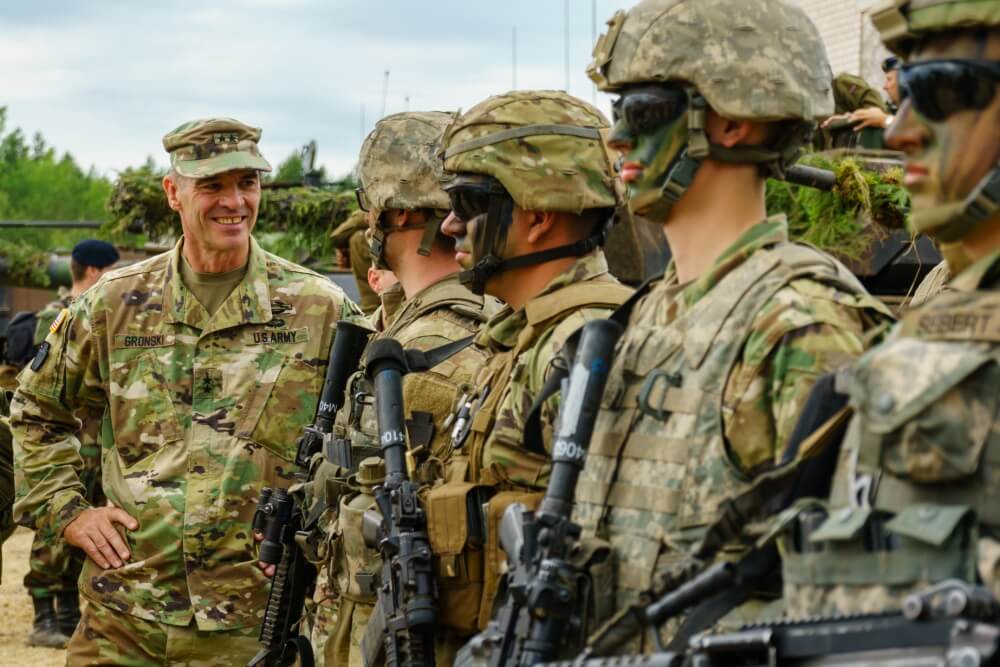Setting precedent.
When Maj. Gen. John Gronski, U.S. Army Europe Deputy Commanding General for Army National Guard, stepped into his current assignment in 2016 there was no precedent. He would be the first person in this role, leaving him to define what the priorities should be for leading the 30,000+ soldiers in theater—including 22,000 permanent personnel and 8,100 rotational forces, according to US Army Europe.
His focus became communication and readiness.
“What I really wanted to do was interact with the soldiers, not only from the assigned forces that we have in Europe, but also from the rotational forces we have coming over. I didn’t want it to be component-centric. I didn’t want it to be just me focusing on National Guard, but National Guard, active component, reserves, and just really being out there to see what concerns the soldiers had. Make sure that the whole focus is on building readiness—to make sure the training was being done properly and they were getting the resources they need in order to build readiness as well as they could,” Gronski said. “The other part is I did want to ensure that I was communicating back to the adjutants general back here (US) just about what’s going on in Europe, so they understood opportunities that existed to train their units and also opportunities that existed for any individual soldiers.”
Boots on the ground leadership style
Gronski’s priorities remain unchanged today, he says, though he has found better techniques for execution—at the center is relationship building across ranks and nations. He can often be found running or rucking with soldiers. He also strives to connect with units in the US by rallying overseas personnel to participate in events virtually.
“I think it’s important, you know, the whole lead by example aspect of it. I just think it’s important to show soldiers that no matter what rank you are, you’re still going to tackle the physical, difficult things to do, and the mentally challenging things to do,” he said. “And also, you just learn so much from young soldiers, just by being out there doing stuff with them.
It automatically takes barriers down and creates a sense of trust and then you’re able to learn all kinds of things from the soldiers in terms of what they’re thinking these days, what’s important to them, and you’re able to bridge that generational gap,” he added.
And closing that gap is critical for someone who received his commission in 1978. However, even with four decades of service, the fundamentals of what attracted Gronski to stay in are the same.
“The thing is, I really, really loved the Army when I joined—I loved the camaraderie, I loved just the whole spirt, I loved the teamwork aspect of it. I loved the leadership part of it, so it was just something that grew on me and before I knew it, I was in 20 years, 30 years, and now I’m in 40 years.”
America’s presence overseas
Headquartered in Wiesbaden, Germany, U.S. Army Europe’s mission is to provide the U.S. European Command with trained and ready forces; build stronger relationships with our allies and partners; deter potential adversaries; and set conditions for multinational interoperability.
“We are working on improving interoperability, such as the language barrier, the cultural issues and things like, could a Polish trailer hook to an American truck or could an American fueler fuel a Romanian combat vehicle,” said Gronsiki.
Gronski also highlighted the importance of forward training for all components of the U.S. Army, “the active component, reserve, and National Guard soldiers coming over to Europe … it’s not like 40 years ago where most soldiers served in Europe at one time or another, … so just coming over and experiencing the terrain … that pays dividends too because now they have trained in areas more closely aligned with how they would fight and that contributes to a more ready, combat-credible force.”
Despite some of the logistical barriers that exist, Gronski stresses the presence overseas is invaluable for countless reasons, such as economic interests and cultural ties. Part of US Army Europe’s mission includes conducting more than 1,000 theater security cooperation events each year, with more than 50 multinational exercises, according to its website. The symbolism of the US commitment in the region is a vital part of its role as a global leader, Gronski adds.
“We are honored to stand side-by-side with our allies and partners in Europe to maintain overmatch and increase lethality against future threats. Engaging with the militaries of other nations gives our Soldiers the opportunities to learn new skills and perspectives just as we hope they learn from us.”
Maj. Gen. Gronski recently returned from visiting with soldiers of the Tennessee Army National Guard in Poland. To stay up-to-date on his travels, go to Twitter.

